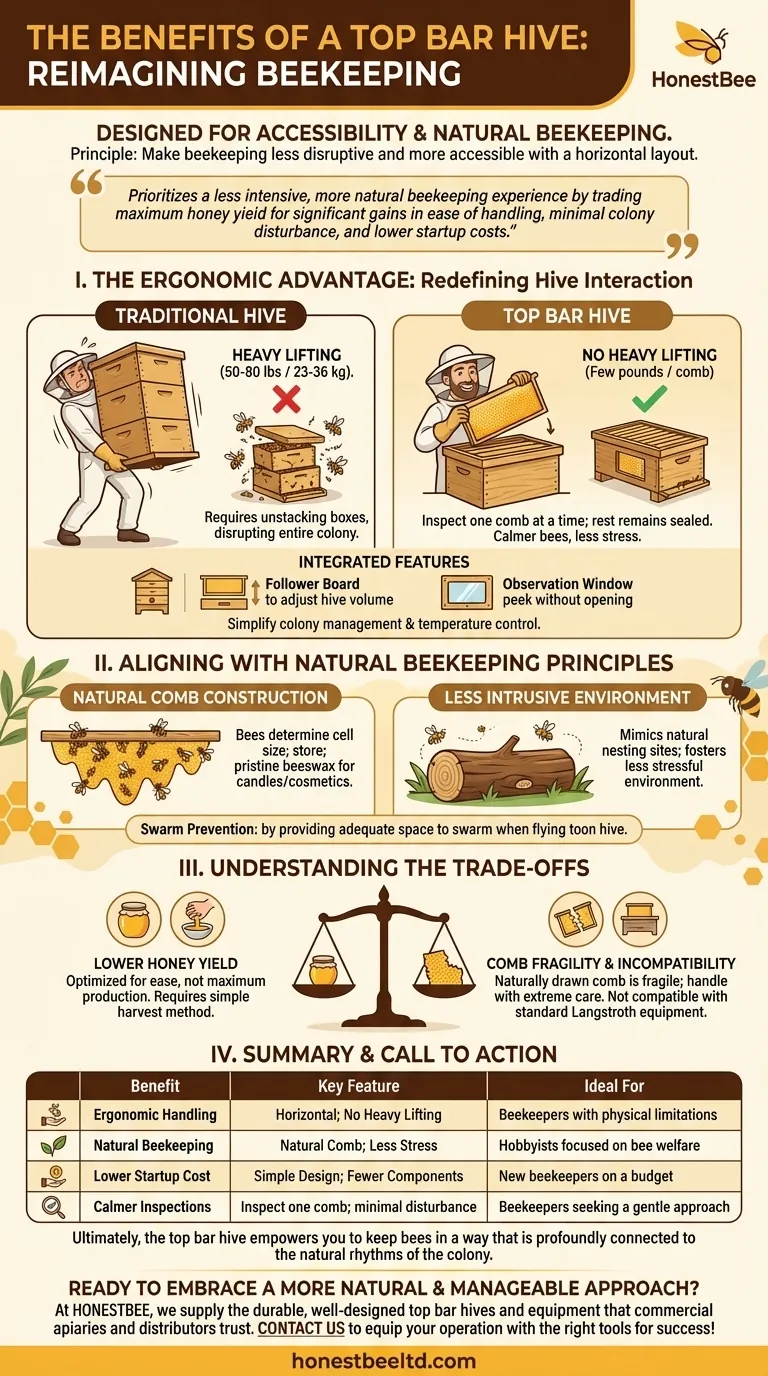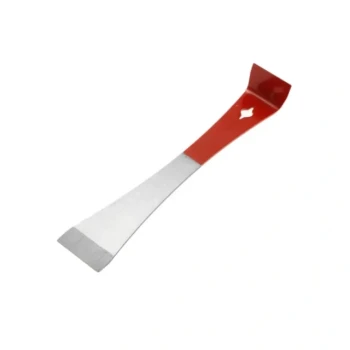At its core, the top bar hive is designed around a single principle: to make beekeeping more accessible and less disruptive. Its horizontal layout allows a beekeeper to inspect the colony one comb at a time without ever lifting a heavy box. This design choice fundamentally changes the physical demands and the nature of hive management compared to traditional vertical hives.
The top bar hive prioritizes a less intensive, more natural beekeeping experience. It achieves this by trading the potential for maximum honey yield for significant gains in ease of handling, minimal colony disturbance, and lower startup costs.

The Ergonomic Advantage: Redefining Hive Interaction
The most immediate benefit of a top bar hive is how it changes the physical interaction between the beekeeper and the hive. It is engineered to remove the most common physical barrier to beekeeping.
Eliminating Heavy Lifting
Traditional Langstroth hives require lifting "supers," which are boxes that can weigh 50-80 pounds (23-36 kg) when full of honey. The top bar hive’s horizontal design completely eliminates this task.
All inspections and harvesting occur by lifting individual combs, which weigh only a few pounds each. This makes beekeeping accessible to people who cannot or do not wish to perform heavy lifting.
A Calmer Inspection Process
In a vertical hive, you must "unstack" the colony to inspect the lower boxes, disrupting tens of thousands of bees at once. This can cause significant stress to the colony.
With a top bar hive, you gently smoke and remove only the one or two combs you wish to inspect. The rest of the colony remains sealed and undisturbed, resulting in calmer bees and a more pleasant experience for the beekeeper.
Integrated Management Features
Many top bar hives include features that simplify colony management. A movable follower board allows you to easily adjust the internal volume of the hive.
This helps the colony manage temperature more efficiently, especially when shrinking the space for winter. Some designs also incorporate an observation window, allowing you to check on the bees' activity without opening the hive at all.
Aligning with Natural Beekeeping Principles
For many, the appeal of the top bar hive goes beyond ergonomics and into the philosophy of beekeeping itself. The design encourages a more hands-off, bee-centric approach.
Promoting Natural Comb Construction
Unlike hives that use pre-made plastic or wax foundation sheets, a top bar hive simply provides a guide. The bees build their comb naturally, drawing it down from the bar.
This allows the bees to determine the cell size and structure themselves, which is a core tenet of natural beekeeping. It also results in pristine beeswax, which is highly valued for candles and cosmetics.
A Less Intrusive Environment
The long, low shape of the hive more closely mimics a fallen log, a natural nesting place for honeybees. This, combined with the minimal disturbance during inspections, fosters a less stressful environment for the colony.
Furthermore, a specific management technique in top bar hives can help prevent swarming by giving the queen adequate space, which helps maintain a strong, productive colony.
Understanding the Trade-offs
No hive design is perfect for every goal. The top bar hive's benefits come with important considerations that may make it unsuitable for some beekeepers.
Honey Yield vs. Ease of Harvest
Top bar hives generally produce less surplus honey than a Langstroth hive, which is optimized for maximum production.
Honey is harvested using the "crush and strain" method, as the combs are not reinforced with wire and cannot be used in a centrifugal extractor. This process is simple and requires no expensive equipment but can be slower and messier.
Comb Fragility
Naturally drawn comb is held together only by the wax the bees produce. It is far more fragile than the wired frames used in other hives.
New beekeepers must learn to handle these combs with extreme care, always keeping them in a vertical orientation to prevent them from breaking off the top bar.
Equipment Incompatibility
Top bar hives and their components are not standardized. The comb size is not compatible with Langstroth equipment, which can make it more difficult to buy or sell established colonies (nucs) or source replacement parts.
Is a Top Bar Hive Right for You?
Choosing a hive is about matching the design to your personal beekeeping goals.
- If your primary focus is maximizing honey production for sale: A Langstroth hive is a more efficient and industry-standard choice.
- If your primary focus is a natural, low-impact hobby with a focus on pollination and bee welfare: The top bar hive's philosophy and gentle management style are an ideal fit.
- If your primary focus is avoiding heavy lifting due to physical limitations: The horizontal, no-lift design of a top bar hive is its single greatest advantage.
Ultimately, the top bar hive empowers you to keep bees in a way that is profoundly connected to the natural rhythms of the colony.
Summary Table:
| Benefit | Key Feature | Ideal For |
|---|---|---|
| Ergonomic Handling | Horizontal design; no heavy lifting | Beekeepers with physical limitations |
| Natural Beekeeping | Bees build natural comb; less colony stress | Hobbyists focused on bee welfare |
| Lower Startup Cost | Simple design; fewer components | New beekeepers on a budget |
| Calmer Inspections | Inspect one comb at a time; minimal disturbance | Beekeepers seeking a gentle approach |
Ready to embrace a more natural and manageable approach to beekeeping? At HONESTBEE, we supply the durable, well-designed top bar hives and equipment that commercial apiaries and distributors trust. Let us help you equip your operation with the right tools for success. Contact our expert team today to discuss your wholesale needs!
Visual Guide

Related Products
- Long Langstroth Style Horizontal Top Bar Hive for Wholesale
- Top Bar Beehive for Beekeeping Wholesales Kenya Top Bar Hive
- HONESTBEE Professional Long Handled Hive Tool with Precision Cutting Blade
- HONESTBEE Professional Multi-Functional Hive Tool with Ergonomic Wood Handle
- HONESTBEE Advanced Ergonomic Stainless Steel Hive Tool for Beekeeping
People Also Ask
- What are the most popular types of hives besides the Langstroth? Top Bar & Horizontal Hives Explained
- What are the box management requirements for a top bar hive vs. Langstroth? Choose Your Hive Strategy
- How does the top bar hive help control varroa mites? A Natural Approach to Mite Management
- What are the benefits of the top bar hive? A Guide to Ergonomic, Natural Beekeeping
- How are entrances designed in top bar hives? Master Beehive Layout for Maximum Honey



















